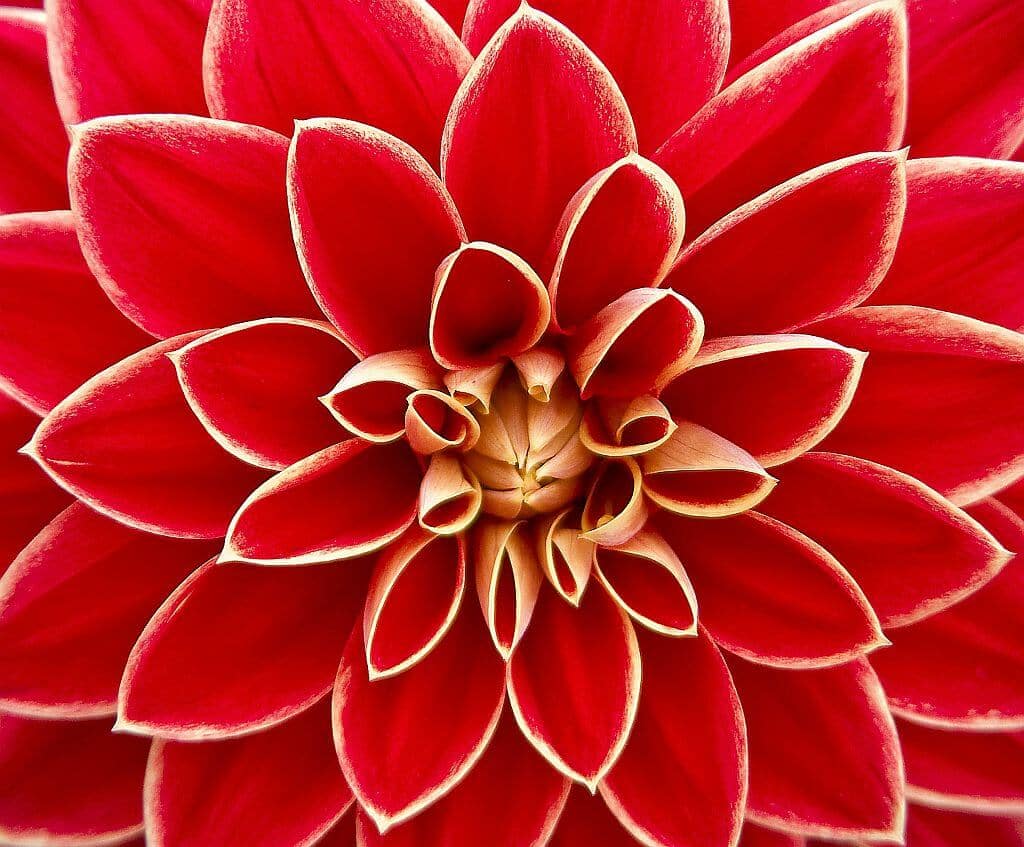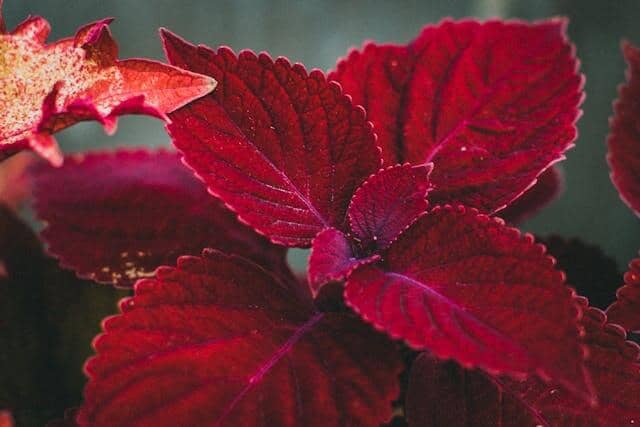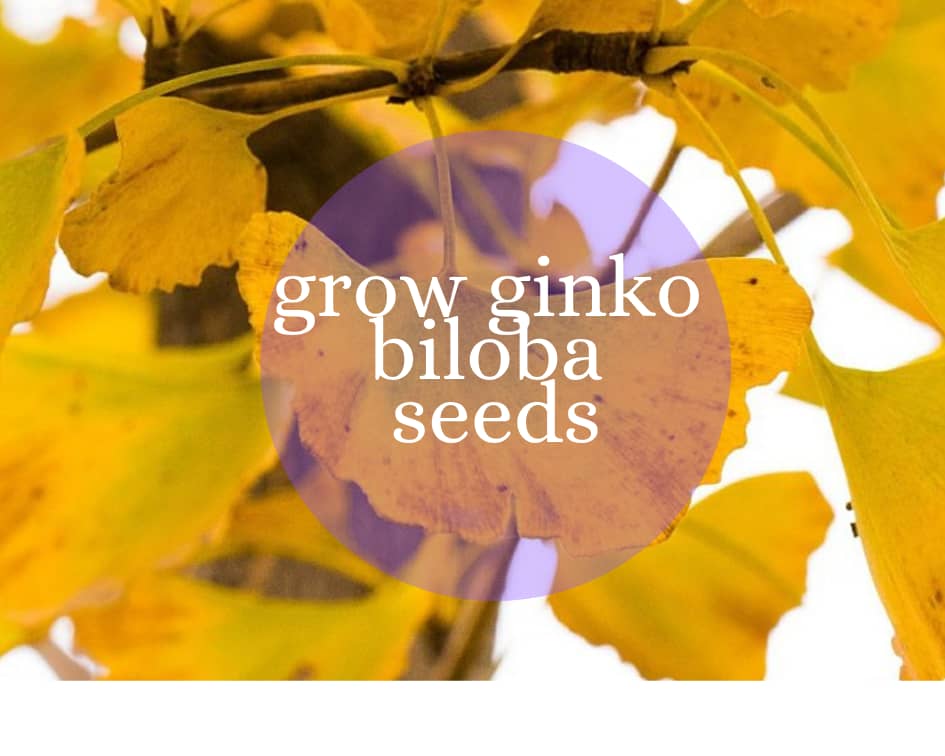This post may contain affiliate links. As an Amazon Associate we earn from qualifying purchases.
Red flowers or foliage add that just-right and dramatic pop of color to the garden. We offer a long list of some of the best.
I walked out into my garden this morning and stood back to take a good long look. Something was missing. Color—specifically red. I have purple and yellow flowers galore (love that combination) but only one plant, a hibiscus, that puts out red flowers.
I needed red in my garden and I needed it fast. So, I did the research as to which plants I can grow and now I’m sharing it with you.
If you’re looking for a pop of color in your garden, consider something from this huge list of plants with red flowers or foliage.
Plants with stunning red foliage
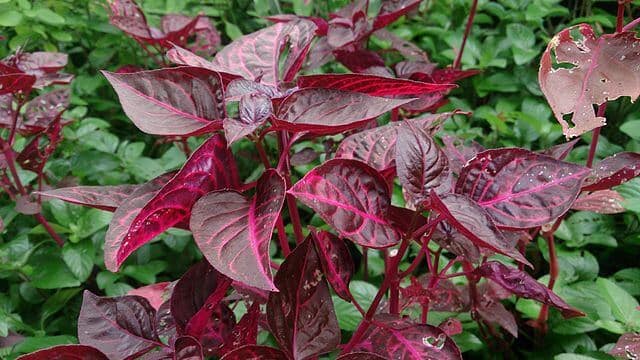
Irisene (Irestine herbstii)
This one is far too pretty to have the nickname “bloodleaf.” One of my all-time favorites, this is just as gorgeous in person as it is in the above photo.
Our summers get super hot so I grow mine in pots on a shaded patio. Yes, it is heat tolerant, but not where-are-we-on-Venus? type of direct sun.
- USDA Hardiness Zone: 10-11
- Perennial or Annual: Perennial in warm climates, annual elsewhere
- Sun or Shade: Partial shade to full sun
- Watering Needs: Regular; keep soil moist
- Heat Tolerant: Yes
- Cold Tolerant: No
- Toxic to Children and Pets: No
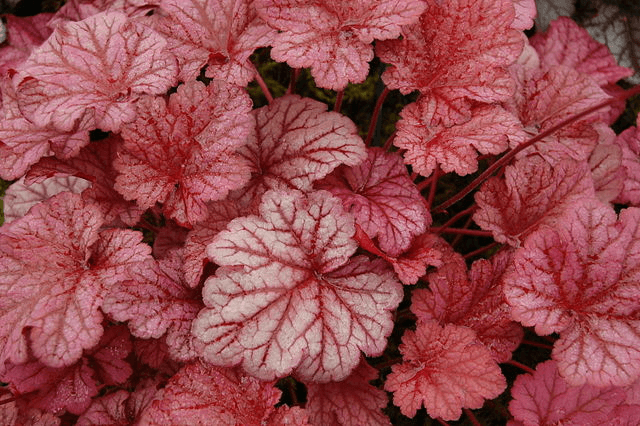
Heuchera (Coral Bells)
Also known as “coral bells,” all but one species of heuchera are native to North America. The Berry Smoothie that is pictured above is ideal for the beginning gardener. It’s low maintenance, very forgiving of newbie mistakes and takes summer’s heat like a champ.
Two others that you may want to consider include ‘Fire Chief’ (Heuchera ‘Fire Chief’ ppaf) and ‘Firefly’ (Heuchera sanguinea ‘Firefly’).
- USDA Hardiness Zone: 4-9
- Perennial or Annual: Perennial
- Sun or Shade: Partial shade
- Watering Needs: Regular; keep soil moist but well-drained
- Heat Tolerant: Yes
- Cold Tolerant: Yes
- Toxic to Children and Pets: No
 Coleus
Coleus
Be still my heart. I so love coleus. The one thing to keep in mind, however, is that it doesn’t grow true from seed. If you have your heart set on a certain variety, look for a starter plant for sale. Etsy typically has a couple of shops who sell lots of different coleus.
Since you obviously like red, like me, look for Coleus ‘Redhead,’ Coleus ‘Royale Cherry Brandy®,’ and ‘Red Oxblood’ coleus.
Learn how to propagate coleus from seed or cuttings.
- USDA Hardiness Zone: 10-11
- Perennial or Annual: Perennial in warm climates, annual elsewhere
- Sun or Shade: Partial shade
- Watering Needs: Regular; keep soil moist
- Heat Tolerant: No
- Cold Tolerant: No
- Toxic to Children and Pets: No
Plants with gorgeous red flowers

Pelargonium
One of my gardening pet peeves is how the pelargonium doesn’t get the credit its due. People (even professionals) continue to call it geranium, even though the geranium is distinctly different and not as pretty in my opinion.
Learn about the differences in our blog post Pelargonium/Geranium Plant Propagation.
Ok, some of our favorite red flowers are pelargoniums that happen to be red. Look for the red flowers of the Pelargonium inquinans, also known as the scarlet geranium, Proven Winners’ Americana Cherry Rose (Pelargonium zonale), Calliope® Large Dark Red (Pelargonium interspecific).
- USDA Hardiness Zone: 9-12
- Perennial or Annual: Perennial in warm climates, annual elsewhere
- Sun or Shade: Full sun to partial shade
- Watering Needs: Moderate; let the soil dry out between waterings
- Heat Tolerant: Yes
- Cold Tolerant: No
- Toxic to Children and Pets: Yes, mildly toxic

Azalea
The first thing you need to know is that azaleas require acidic soil. This brings the maintenance factor up significantly. But, hey, for flowers like those in the photo above, it’s a low price to pay.
We rounded up several stellar azalea plants (with red flowers!) for you to check out. ‘Red Formosa,’ Encore Autumn Fire®, Girard’s Crimson Azalea, Perfecto Mundo (Rhododendron x ‘NCRX’8) and Red Azalea Mollis Hybrid (Rhododendrom x obtusum).
Plan to grow your azalea in a pot? Check out our blog post on How to Care for Potted Azaleas.
- USDA Hardiness Zone: 5-9
- Perennial or Annual: Perennial
- Sun or Shade: Partial shade
- Watering Needs: Regular; keep soil consistently moist
- Heat Tolerant: Moderately
- Cold Tolerant: Yes
- Toxic to Children and Pets: Yes

Pentas
What an easy grower this one is. This is another one that I grow in pots on my lightly shaded patio. Just provide water so that the soil is moist at all times and it will bloom its fool head off, while adding that amazing pop of red.
Red pentas worth checking out include Pentas Lanceolata ‘Sunstar® Red,’ Pentas lanceolata ‘Graffiti Red Velvet,’ Pentas lanceolata ‘Graffiti OG Bright Red,’ and ‘Kaleidoscope.’
- USDA Hardiness Zone: 10-11
- Perennial or Annual: Perennial in warm climates, annual elsewhere
- Sun or Shade: Full sun
- Watering Needs: Regular; keep soil moist but not waterlogged
- Heat Tolerant: Yes
- Cold Tolerant: No
- Toxic to Children and Pets: No

Canna Lily
It’s amazing, isn’t it, how being gorgeous as a flower doesn’t mean you’re difficult to grow. Canna lilies are some of the easiest growers in my garden. They thrive in the sun and heat and bloom like crazy.
Red cannas worth hunting down include ‘Red King Humbert‘ (Canna x generalis), ‘The President‘ (Canna x generalis) ‘Red Futurity’ and ‘ Red Dazzler'(Canna x generalis ‘Red Dazzler’).
Learn How to Care for a Canna Lily.
- USDA Hardiness Zone: 8-11
- Perennial or Annual: Perennial
- Sun or Shade: Full sun
- Watering Needs: Regular; keep soil moist
- Heat Tolerant: Yes
- Cold Tolerant: No
- Toxic to Children and Pets: No
 Tropical Hibiscus
Tropical Hibiscus
There isn’t any garden plant in bloom that can compare to the tropical hibiscus (Hibiscus rosa-sinensis), in my opinion. The large, showy flowers just scream out to those viewing them. Hibiscus flowers are typically yellow, pink, orange, mixed colors and, yes, red.
They do have a bit of a diva reputation, but don’t believe what you hear. They’re easy to care for if you keep the soil moist at all times during the hot summer and back off on watering during other times of the year.
Shop for this gorgeous ‘Double Red’ hibiscus (Hibiscus rosa-sinensis ‘Double Red’), ‘President’s Red’ Tropical Hibiscus (Hibiscus rosa-sinensis ‘President’s Red’), Hollywood ‘First to Arrive’ (Hibiscus rosa-sinensis ‘Hollywood First To Arrive’)
Read our complete guide about How to Grow Hibiscus.
- USDA Hardiness Zone: 10-12
- Perennial or Annual: Perennial
- Sun or Shade: Full sun to partial shade
- Watering Needs: Moderate; drought-tolerant once established
- Heat Tolerant: Yes
- Cold Tolerant: No
- Toxic to Children and Pets: No

Red Valerian
If you’re longing for a deep red in the garden, check out red valerian (Centranthus ruber). The rich, dark red flowers rise above a shrubby plant that can reach 3 feet in height.
Red valerian produces a ton of flowers from summer through fall. Shop for Centranthus ruber ‘Coccineus’ and let the floral show begin!
- USDA Hardiness Zone: 5-8
- Perennial or Annual: Perennial
- Sun or Shade: Full sun to partial shade
- Watering Needs: Moderate; drought-tolerant once established
- Heat Tolerant: Yes
- Cold Tolerant: Yes
- Toxic to Children and Pets: No

Lobelia
Commonly known as the cardinal flower, lobelia is a standout in the garden. Give it 4 to 6 hours of direct sunlight and very moist soil and it will bloom like crazy.
Check these out: Lobelia Starship™ Scarlet, Lobelia ‘Scarlet Princess’ and Lobelia specious ‘Vulcan Red.’
- USDA Hardiness Zone: 2-10 (varies by species)
- Perennial or Annual: Both, depending on species
- Sun or Shade: Full sun to partial shade
- Watering Needs: Regular; keep soil moist
- Heat Tolerant: No
- Cold Tolerant: Yes
- Toxic to Children and Pets: Yes

Begonia (Wax)
Begonias don’t survive in my climate so I am quite envious of you gardeners that can grow them. Talk about a pop of color! Red begonias add so much to a border or bed.
Take a look at some of these cultivars and you’ll be sold! Proven Winners’ Begonia Benariensis ‘Surefire® Red,’ Scarlet double begonia (Begonia semperflorens), Harmony Scarlet (Begonia x semperflorens-cultorum)
- USDA Hardiness Zone: 10-11
- Perennial or Annual: Perennial in warm climates, annual elsewhere
- Sun or Shade: Partial shade
- Watering Needs: Regular; keep soil moist but not soggy
- Heat Tolerant: No
- Cold Tolerant: No
- Toxic to Children and Pets:
Learn How to Care for Angel Wing Begonias.

Verbena
If you love star-shaped flowers you’ll need to plant some red verbena. A gorgeous plant, it’s also quite low- maintenance. It grows well in a range of soils, and it doesn’t mind if you plant it in a hanging basket, a pot, or in the garden. They’re especially attractive when planted en masse.
As a bonus, when you grow verbena you’ll get a butterfly show as well! They adore this plant.
For a striking red version, shop now for ‘Tukana Scarlet’ verbena, Superbena® Red Verbena,Verbena peruviana ‘Red Devil,’ Red EnduraScape™ Verbena (Verbena peruviana ‘Balendred’ PP26132)
- USDA Hardiness Zone: 7-11
- Perennial or Annual: Perennial in warm climates, annual elsewhere
- Sun or Shade: Full sun
- Watering Needs: Moderate; drought-tolerant once established
- Heat Tolerant: Yes
- Cold Tolerant: No
- Toxic to Children and Pets: No

Salvia
I grow a few different colored salvia but no red! Crazy, I know. Hot Lips, pictured above, is one of the most popular red cultivars and for good reason. It’s one of the cutest little flowers I’ve seen.
Ready to shop? Check out scarlet sage (Salvia splendens), Salvia coccinea, which is also commonly known as scarlet sage, although the plants are different.
Others to consider include ‘Roman Red,’ a cross between S. splendens and darcyi., and Furman’s Red Salvia(Salvia greggii ‘Furman’s Red’).
- USDA Hardiness Zone: 4-10 (varies by species)
- Perennial or Annual: Both, depending on species
- Sun or Shade: Full sun
- Watering Needs: Moderate
- Heat Tolerant: Yes
- Cold Tolerant: Yes
- Toxic to Children and Pets: No

Astilbe
The folks at AmericanMeadows.com call the astilbe’s flowers “Bright, Wisps of Color,” and I couldn’t think of a better description.
The main problem you’ll have when planting is to find the perfect spot. Too much shade and flowering isn’t as profuse. Too much sun and the poor baby will fry. But you’ve got this. We have every faith.
Shop for ‘Fanal Red’ (Astilbe x arendsii) or ‘Spinell’ (Astilbe chinensis ‘Spinell).
- USDA Hardiness Zone: 4-9
- Perennial or Annual: Perennial
- Sun or Shade: Partial to full shade
- Watering Needs: Regular; keep soil moist
- Heat Tolerant: No
- Cold Tolerant: Yes
- Toxic to Children and Pets: No
Check out our post on How to Divide Astilbe

Coneflower (Echinacea)
Whether you call it coneflower or by its formal name, Echinacea, one thing is certain: you are not alone in falling in love with this flowering plant. In fact, it’s one of the most popular plants among American gardeners.
The red coneflowers are brilliant. Here are a couple of our faves: PRAIRIE STARS™ Tomato Soup Coneflower (Echinacea x ‘Tomato Soup’), Sombrero® Salsa Red Coneflower (Echinacea x ‘Balsomsed’) and Sombrero® Sangrita Coneflower (Echinacea x ‘Balsomanita’).
- USDA Hardiness Zone: 3-9
- Perennial or Annual: Perennial
- Sun or Shade: Full sun
- Watering Needs: Moderate; drought-tolerant once established
- Heat Tolerant: Yes
- Cold Tolerant: Yes
- Toxic to Children and Pets: No

Red Ginger (Alpinia purpurata)
How about adding an exotic flare to the garden? Red ginger just screams “TROPICAL!” As a tropical plant, however, it is a bit demanding about its environment. It enjoys filtered sunlight with warm, humid weather. You can, however, grow it indoors on a humidity tray and lots of indirect sunlight.
Shop for red ginger at Plantvine.com and Amazon.com.
- USDA Hardiness Zone: 9-12
- Perennial or Annual: Perennial
- Sun or Shade: Partial shade
- Watering Needs: Regular; keep soil moist
- Heat Tolerant: Yes
- Cold Tolerant: No
- Toxic to Children and Pets: No
Fuchsia
Easy to grow? Yes, it is. But only if you can provide its required conditions.
Although it thrives in shade, the fuchsia needs filtered sunlight for a few hours a day to produce the adorable, dangling flowers. If you live in an part of the world where it is excessively hot in the summer, fuchsia isn’t for you (or me, sadly).
Arid climates don’t agree with the plant but, luckily, there are plenty of other red-flowering plants from which to choose.
When shopping for fuchsia, look for Fuchsia Corabells Red White (Fuchsia hybrida), Diva® Red/White and ‘Fuchsia Marcia.‘
- USDA Hardiness Zone: 10-11
- Perennial or Annual: Perennial in warm climates, annual elsewhere
- Sun or Shade: Partial to full shade
- Watering Needs: Regular; keep soil moist
- Heat Tolerant: No
- Cold Tolerant: No
- Toxic to Children and Pets: Yes
 Tulip
Tulip
Tulips are such fun. I don’t know why, but the word I come up with for them is “cheery.” They just put a smile on my face.
Plant the bulbs in the fall and you’ll see the flowers in late winter or spring. They’re supposed to be perennials, meaning they come back year after year. The folks at Almanac.com, however, warn that “… many centuries of hybridizing means that the bulb’s ability to return year after year has weakened.”
Tulips worth looking up online include Kingsblood (can you believe that red?), Pinocchio Greigii (red with white edges) and Canasta Fringed Tulip.
Grow them in pots? Of course! Check out our blog post How to Plant Tulip Bulbs in Pots.
- USDA Hardiness Zone: 3-8
- Perennial or Annual: Perennial (but often treated as annual)
- Sun or Shade: Full sun to partial shade
- Watering Needs: Regular during growth, dry during dormancy
- Heat Tolerant: No
- Cold Tolerant: Yes
- Toxic to Children and Pets: Yes
Trees and shrubs that offer a pop of red in the garden

Japanese Maple
Japanese maples are so incredibly beautiful, with their wispy aspect and vibrant color. The ‘Bloodgood’ cultivar, for instance, boasts some of the most gorgeous foliage ever.
I have a fondness for the Coral Bark Japanese maple. Although the leaves are green, the bark is a stunning shade of red. Check them both out:
Coral Bark Japanese Maple (Acer palmatum ‘Sango-kaku’)
You might also want to take a look at ‘Red Dragon,’ ‘Emperor” and ‘Cascade.’
- USDA Hardiness Zone: 5-8
- Perennial or Annual: Perennial
- Sun or Shade: Partial shade
- Watering Needs: Regular; keep soil moist
- Heat Tolerant: No
- Cold Tolerant: Yes
- Toxic to Children and Pets: No

Rose
Of course no blog post about beautiful red flowering plants is complete without mention of roses. Rose shrubs aren’t as difficult to care for as some would have us believe. They are actually quite tough and, when cared for properly, they’ll pay you back in dividends.
Check out these red beauties:
‘Showbiz’ (floribunda)
‘Smokin’ Hot’ (hybrid tea)
‘Chrysler Imperial’ (hybrid tea)
Blaze Improved (climbing rose)
- USDA Hardiness Zone: 3-11 (varies by species)
- Perennial or Annual: Perennial
- Sun or Shade: Full sun
- Watering Needs: Regular; deep watering preferred
- Heat Tolerant: Yes
- Cold Tolerant: Yes
- Toxic to Children and Pets: No
Learn How to Get a Rose Bush to Bloom
 Photinia
Photinia
That gorgeous guy in the photo above is Photinia ‘Red Robin.’ Commonly used as a hedging plant, photinia provides just about year-round interest, from the foliage to the flowers and the berries at the end of the season.
You might want to check out the brilliant ‘Red Tip’ photinia
- USDA Hardiness Zone: 7-9
- Perennial or Annual: Perennial
- Sun or Shade: Full sun to partial shade
- Watering Needs: Moderate
- Heat Tolerant: Yes
- Cold Tolerant: Yes
- Toxic to Children and Pets: No
Hope this helps you get started with adding that pop of red to your garden! Let me know in the comments if you need more details on any of these plants.
